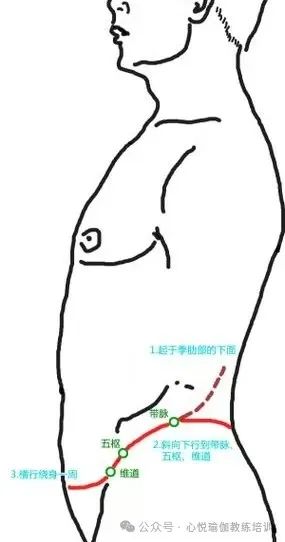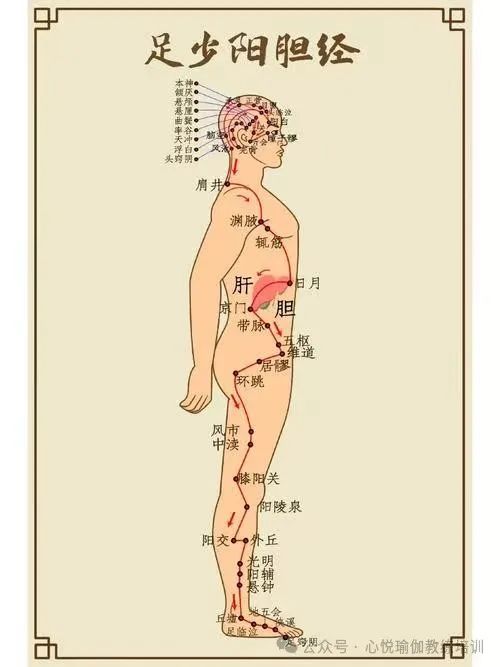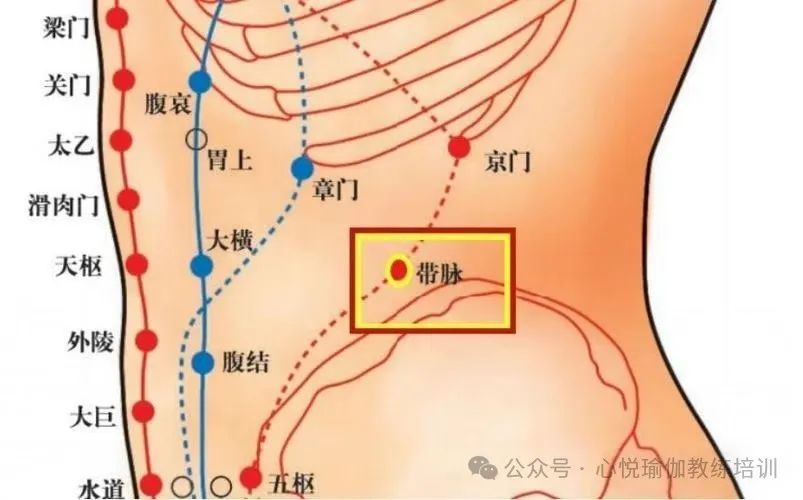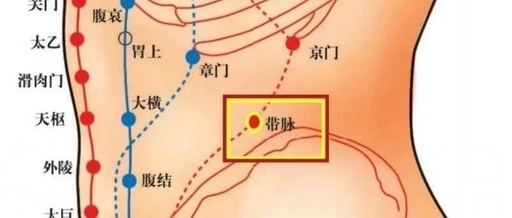The Dai Mai, as one of the Eight Extraordinary Meridians, is first mentioned in the ancient texts of the Huangdi Neijing in the section Ling Shu: Jing Bie, with a detailed description of its pathway found in the Nanjing: Twenty-Eight Difficulties.
1. Huangdi Neijing: Ling Shu
The Ling Shu: Jing Bie first mentions the existence of the Dai Mai, establishing its theoretical foundation as one of the Eight Extraordinary Meridians, but does not provide a detailed description of its pathway.
2. Nanjing: Twenty-Eight Difficulties
It clearly records the characteristics of the Dai Mai’s pathway: “The Dai Mai originates at the lateral costal region and encircles the body.” This is the first systematic description of the Dai Mai’s pathway, indicating that it starts at the lateral costal area (below the lower ribs) and has a circular pathway around the waist and abdomen.
3. Additional Classical Texts
Later medical texts such as Zhenjiu Dacheng and Study of the Eight Extraordinary Meridians further elaborate on the functions and clinical applications of the Dai Mai, although they are not the earliest records.
The Huangdi Neijing serves as the foundational work of TCM theory, incorporating the Dai Mai into the meridian system for the first time, while the Nanjing refines its pathway, together constructing the theoretical framework of the Dai Mai as the “convergence of all meridians,” providing a basis for the diagnosis and treatment of gynecological issues and lower back pain in later generations.

1. Pathway of the Dai Mai
The Dai Mai is the only horizontal meridian that encircles the waist and abdomen, resembling a belt that constrains the vertical meridians and has the core function of “converging all meridians,” playing a broad role in regulating the lower jiao and maintaining the balance of the organs. It is one of the Eight Extraordinary Meridians, with a unique pathway:
Starting Point:
The Dai Mai originates at the lateral costal region, specifically located below the side abdomen (approximately below the free end of the 11th rib), adjacent to the Zhangmen (章门) point of the Foot Jueyin Liver Meridian (足厥阴肝经). This is the initial point of the Dai Mai’s pathway.
Pathway:
From the lateral costal region, it descends diagonally to the Dai Mai (带脉) point (located 1.8 cun below the Zhangmen (章门) point, level with the navel), then moves forward to the upper edge of the hip bone and descends diagonally along the upper edge, encircling the waist and abdomen horizontally through points such as Wushu (五枢) and Weidao (维道), ultimately returning to the starting point (lateral costal region). Thus, the endpoint of the Dai Mai coincides with the starting point, forming a closed circular pathway.
Key Pathway Characteristics
1. Encircling the waist: The Dai Mai is the only horizontal meridian, encircling the waist and abdomen like a belt, constraining the vertical meridians.
2. Intersection Points: It intersects with the Foot Shaoyang Gallbladder Meridian (足少阳胆经) at the Dai Mai (带脉), Wushu (五枢), and Weidao (维道) points (all located on the lateral abdomen).
Characteristics: The Dai Mai is the only horizontally distributed meridian, traversing the waist and abdomen, constraining the vertical flow of the twelve regular meridians, known as the “convergence of all meridians.”
2. Dai Mai Points and Intersecting Meridians
In the TCM meridian system of the Eight Extraordinary Meridians, only the Ren Mai and Du Mai have their own exclusive points, while the other six meridians (including the Dai Mai, Chong Mai, Yin Wei, Yang Wei, Yin Qiao, and Yang Qiao) do not have independent points. The function of the Dai Mai is mainly realized through its intersection points with other meridians (especially the Foot Shaoyang Gallbladder Meridian).
1. Points Associated with the Dai Mai
The pathway of the Dai Mai is closely related to the Foot Shaoyang Gallbladder Meridian, and its key points belong to the Gallbladder Meridian:
Dai Mai (带脉) Point (GB26): Located on the lateral abdomen, at the intersection of the vertical line from the free end of the 11th rib and the horizontal line at the level of the navel.
Wushu (五枢) Point (GB27): Located on the inner side of the anterior superior iliac spine, at the intersection of the horizontal line 3 cun below the navel (level with Guanyuan (关元) point).
Weidao (维道) Point (GB28): Located 0.5 cun anterior to the Wushu point.
These points, although traversed by the Dai Mai, are essentially points of the Gallbladder Meridian, existing only as “intersection points” between the Dai Mai and Gallbladder Meridian.
2. Intersecting Meridians:
Directly intersecting meridians
1. Foot Shaoyang Gallbladder Meridian (胆经)
Intersection Points: Dai Mai Point (GB26), Wushu Point (GB27), Weidao Point (GB28).
Relationship: The Dai Mai directly intersects with the Gallbladder Meridian at these three points on the lateral abdomen, forming key points for the mutual flow of Qi and blood, jointly regulating the lower jiao and gynecological issues.

Indirectly related meridians
1. Foot Jueyin Liver Meridian (肝经)
Relationship: Through the interrelationship between the Gallbladder Meridian and the Liver Meridian (Gallbladder is Yang, Liver is Yin), the Dai Mai is indirectly connected to the Liver Meridian.
Functional Impact: The Liver Meridian governs the smooth flow of Qi, and the Dai Mai, by regulating the Qi of the Liver and Gallbladder Meridians, indirectly affects gynecological diseases (such as irregular menstruation and dysmenorrhea).
2. Du Mai
Intersection Point: Mingmen Point (located below the spinous process of the second lumbar vertebra).
Relationship: The Dai Mai encircles the waist and intersects with the Du Mai at the Mingmen point, jointly regulating the functions of the lumbar spine and kidney Qi.
3. Ren Mai
Associated Points: Zhongji Point, Guanyuan Point.
Relationship: The Dai Mai, by encircling the waist and abdomen, forms a “vertical-horizontal” intersection with the Ren Mai in the lower abdomen, collaboratively regulating the reproductive system and the Yuan Qi of the lower jiao.
4. Chong Mai
Associated Point: Qichong Point (belonging to the Stomach Meridian, the starting point of the Chong Mai).
Relationship: The Dai Mai and Chong Mai both originate from the uterus, jointly regulating the influence of Qi and blood on the uterus, such as menstruation and leukorrhea issues.
5.Foot Taiyang Bladder Meridian
Associated Points: Shenshu Point, Dachangshu Point, and other lumbar points.
Relationship: The Dai Mai, by encircling the waist, forms a Qi and blood interaction with the Bladder Meridian in the lumbar and sacral regions, regulating lower back pain and urogenital issues.
3. Main Functions and Effects of the Dai Mai
1. Constraining the vertical meridians: The Dai Mai encircles horizontally, like a belt, constraining the twelve regular meridians and the Eight Extraordinary Meridians, preventing them from descending or ascending, primarily governing the flow of Qi and blood in the waist and abdomen, maintaining the balance of Qi and blood in the waist and abdomen, closely related to the digestive and reproductive systems.。
2. Governing reproduction and gynecology: Connected with the Chong, Ren, and Du Mai, it governs leukorrhea issues. TCM believes that “Dai Mai disorders lead to leukorrhea in women,” and weakness of the Dai Mai can easily lead to abnormal leukorrhea, irregular menstruation, dysmenorrhea, uterine prolapse, and other gynecological issues.
3. Protecting the kidneys and lumbar vertebrae: The waist is the residence of the kidneys; a strong Dai Mai can alleviate lower back pain, lumbar disc herniation, and other issues.
4. Metabolic impact: Blockage of the Dai Mai can easily lead to the accumulation of excess fat in the waist and abdomen due to Qi and blood stagnation and slowed metabolism.。
4. The Relationship Between the Dai Mai and Health
1. The “culprit” of obesity:
Blockage of the Dai Mai can lead to the accumulation of excess fat in the waist and abdomen. Due to weakened constraining force of the Dai Mai, it cannot suppress excessive fat growth, forming a “spare tire.” Clinically, it is found that individuals with abdominal obesity often have Dai Mai blockage.
2. The “switch” for gynecological diseases:
The Dai Mai is connected to the uterus, closely related to women’s menstruation, leukorrhea, pregnancy, and childbirth. Dysfunction of the Dai Mai can lead to irregular menstruation, dysmenorrhea, and leukorrhea issues (such as abnormal leukorrhea). The Nanjing states that weakness of the Dai Mai leads to “red and white leukorrhea,” highlighting its close connection to gynecological health.
3. The “regulator” of Qi and blood throughout the body:
The Dai Mai is closely related to the functions of the liver, gallbladder, spleen, stomach, and kidneys. When the Dai Mai is blocked, it can easily lead to constipation, abdominal distension, and weakness in the lower back and knees, even affecting the flow of Qi and blood in the five organs.
Appendix: Signals of Dai Mai Blockage
Loose waist and abdomen: Abdominal obesity, stubborn waist and abdominal fat, muscle weakness.
Gynecological issues: Clear and thin leukorrhea, cold sensation in the lower abdomen, dysmenorrhea, infertility.
Disorder of urination and defecation: Frequent urination, enuresis, or constipation.
Weakness in the lower limbs: Dysfunction of the Dai Mai may lead to weakness and edema in the lower limbs.
Dai Mai stasis: Commonly seen in lumbar muscle strain, lumbar disc herniation, and other musculoskeletal diseases.
5. Daily Health Care Methods for the Dai Mai
TCM believes that “Dai Mai dysfunction” (weak constraining force) is the root of many diseases. By nurturing the Dai Mai, not only can local obesity and gynecological issues be improved, but it can also regulate the flow of Qi and blood throughout the body, achieving a health effect of “pulling one hair affects the whole body.”
1. Moxibustion and Heat Therapy:
Moxibustion on the Dai Mai point and Guanyuan point can warm and unblock the Dai Mai, dispelling cold and dampness, improving dysmenorrhea and diarrhea.
Using a warm water bag for heat therapy on the lower back promotes Qi and blood circulation.
2. Massage and Tapping:
Massage the Dai Mai point: Press the Dai Mai point with both thumbs, moving in a clockwise direction for 3 minutes to relieve lower back soreness.
Tap the Dai Mai: With a fist, lightly tap from the side of the waist towards the navel, focusing on stimulating the Zhangmen (章门), Wushu (五枢), and Weidao (维道) points for 5 minutes each time, which can clear the liver and gallbladder, detoxify, and help reduce abdominal fat.
3. Guiding and Exercise:
The Eight Pieces of Brocade: “Two Hands Grasping Feet to Strengthen the Kidneys and Waist”: Stretching the Dai Mai, strengthening the waist and abdominal muscles.
Yoga Pose: Cow Face Twist
4. Lifestyle Habits:
Avoid prolonged sitting, as sitting for long periods compresses the Dai Mai, easily leading to Qi and blood stagnation; get up and move the waist every hour.
Women should pay attention to keeping the waist and abdomen warm during menstruation and avoid wearing crop tops.
5. Dietary Regulation
Reduce cold and greasy foods, and eat more warming and tonifying foods for the spleen and kidneys (such as yam and walnuts), avoiding exacerbating Dai Mai blockage.
The Dai Mai is like an invisible “belt,” silently protecting our health. Although short, it is the “hub” and “gate” of Qi and blood flow in the body. By nurturing the Dai Mai, not only can we improve waist and abdominal obesity and gynecological issues, but we can also enhance overall Yang Qi, achieving the effect of “one passage opens a hundred passages.” Combining massage, moxibustion, and moderate exercise in daily life allows this “belt” to safeguard health.
Key Points: The Dai Mai Point (Dài Mài) although its name includes “Dai Mai,” it is not an independent point of the Dai Mai itself, but the 26th point of the Foot Shaoyang Gallbladder Meridian. It is the core point for regulating the Dai Mai,

Main functions include:
Constraining the meridians: Regulating Qi and blood in the waist and abdomen, alleviating lower back pain and abdominal looseness.
Gynecological regulation: Treating irregular menstruation, leukorrhea issues, pelvic inflammation, etc.
Unblocking the liver and gallbladder: Assisting in alleviating gallbladder stagnation causing lateral pain and abdominal distension.
When massaging the Dai Mai point, although stimulating the Gallbladder Meridian, it can indirectly regulate the Dai Mai through the relationship of meridian intersections, achieving the effect of “one point regulates two meridians,” commonly used for:
Weight loss (tightening the waist and abdomen), gynecological diseases, lower back pain, etc.
The Eight Extraordinary Meridians: Chong Mai: The Hub of Life Energy
Ren and Du Meridians: The “Supervisor” of Yang Qi in the Body – Pathway, Points, and Wellness
Ren and Du Meridians: Ren Mai
The Twelve Meridians: Ziwuliuzhu and Wellness
The Twelve Meridians: Interrelationship and Connection Patterns
The Naming of the Twelve Meridians
Heart Joy Yoga (North City Branch)

